A lot of things have changed since February/March this year, and some of these things are not going back to the same exact way they used to be. It’s been said a few times before that this global pandemic has forced quite a few industries to take the inevitable technological changes that were going to take 15-20 years and compress them into a couple of months if not weeks.
One of these industries lies close to my heart – making movies and TV shows (for which I’ve been doing quite a few interviews recently) and getting them to the viewers. As spring went into a long summer, and now fall is going into a long winter with no clear path “out” of the current situation that we find ourselves in, the theatrical / exhibition side of the business is in deep, deep trouble. It is trying to position itself as an integral, vital part of the industry, and yet it’s becoming clearer with each week that passes that they were, well, a middleman.
As I wrote a few weeks ago:
A part of me wishes that the studios were a bit more desperate to release the big blockbusters that were scheduled all through 2020 and then postponed again and again. A part of me wishes to see what kinds of innovations we might see down the road when going to a movie theater is not considered to be a vital part of releasing a movie. Does Disney make some sort of a Marvel Pass that lets me in on all that franchise movies and shows for a flat $50 a year? Do I get a refund if I stopped watching a movie partway through because I didn’t like it? Do I get some sort of a discount for watching the next “Fast & Furious” if I already paid the full price for the last one?
While “Mulan” was undoubtedly a big move from Disney, I see Warner moving “Wonder Woman 1984” to streaming as a much bigger move. And before you say anything, I want to be realistic and say that no, it’s not going to drive huge crowds of viewers into enclosed, dark theatrical spaces where you may or may not be surrounded by complete strangers who may or may not pass on things that you may or may not want to be passed on.
What I do find fascinating is the business side of what used to be the big six, and now the big five movie studios. As I wrote:
Universal is part of NBCUniversal which is, in turn, part of Comcast. Comcast revenue for 2019 was $108.9B. Paramount is part of ViacomCBS. Warner is part of WarnerMedia (along with HBO and CNN) which is, in turn, part of AT&T. AT&T revenue for 2019 was $181B. Disney (after having acquired Pixar, Marvel, Lucasfilm and 20th Century Fox) ruled the domestic market in 2019 with almost 40% share, and the parent conglomerate reported the revenue of $69.5B for 2019.
And while technically they are not desperate to take the huge blockbusters they’ve been sitting on for much of this year and get them to the viewers, every month that passes does add just a bit of pressure to the senior leadership of those smaller divisions to put at least some money into the earnings column.
“Wonder Woman 1984” is going to be made available for no additional charge to all HBO Max subscribers. AT&T has been building up that vertical pipeline for some time now, and understandably, they are anxious to get some of the money flowing back. Universal has Peacock. Disney has Disney+. Paramount has CBS All Access. Columbia is the odd one out, given that Sony pretty much gave up on Vue and Crackle. I actually had to look those up.
I don’t know how things are going to look like going into spring. I’m about 80% positive that Disney will put “Black Widow” on Disney+ in the next few months. I’m about 80% positive that Universal is going to put “Fast & Furious 9” and “No Time To Die” on Peacock before this coming spring is over.
Moving the big releases to the screens that people have on them (phones, tablets) or in their living rooms (flatscreen TVs) was inevitable. It was going to take 5-10 years, no matter how loud the inevitable hand-wringing and doom-spelling that the movie theater trade association lobbyists could be. And even though the original Matrix trilogy didn’t end up well for Agent Smith, this transition is inevitable. By the time it’s done, going to a movie theater will be the same as buying your favorite Lana Del Rey album on vinyl. Charming. Sweet. A bit old-fashioned.
Continuing the ongoing series of interviews with creative artists working on various aspects of movie and TV productions, it is my pleasure to welcome Hillary Spera. In this interview she talks about the hidden complexity of what goes on behind the scenes to bring these stories to our screens, digital vs film, the current production landscape as the Corona-related restrictions are being slowly lifted, and her life-long passion of capturing images. Around these topics and more, Hillary dives deep into her work on the recently released “The Craft: Legacy”.
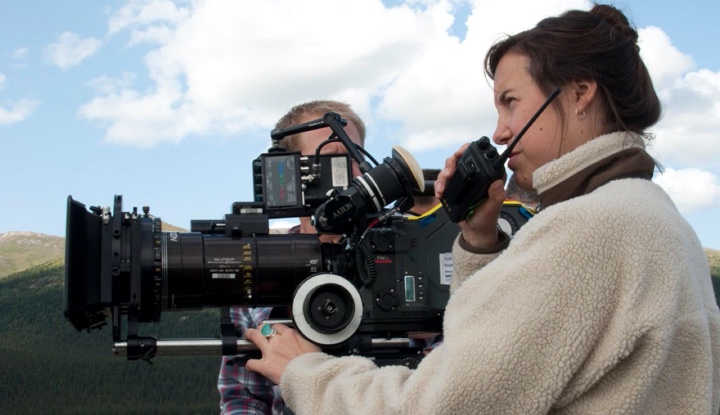
Kirill: Please tell us about yourself and what drew you into this field.
Hillary: I didn’t know early that I wanted to be a cinematographer, but I was always inspired by and interested in still photography. As a kid, I always picking up a camera and took photos whenever I could. It was my favorite way to get out into the world and experience it, through a lens. I had no idea what I was doing, but I was really compelled by it.
When I went to college, still photography continued to be my passion. I did it on my own as a hobby, as I was never formally trained other than a class in high school. There was a lot of trial and error. That college didn’t have a photography program that I was interested in, so I stumbled into cinematography as a way to make images, to tell stories visually. That’s when I found my love for it. It was really fun, I also loved the aspect of collaboration, being part of a team. I ended up shooting everything I could get my hands on, always being present for that, taking every opportunity and never saying no. That’s what took me down the road to being a cinematographer. I never went to grad school for cinematography. I learned from just doing it, from being on set and shooting everything that I could. Making a lot of mistakes and learning from them. And continuing to shoot still photography as well.
Kirill: If you look at the evolution of technology, do you feel that it would be easier for you to get into the field today, as cameras become more affordable and some people are even shooting on their iPhones?
Hillary: I’ve thought about this a lot. I don’t know if I’d be as motivated to get into it now. I love making images. I’ve always made images and I always will. Even on my days off I’m shooting. But I came from film and I love the physical celluloid aspect of it, the tangibility of that. I’m not sure I would have gotten into it if the door had been through an iPhone instead of through film. That said, I do want to think that a love of making images would have prevailed, somehow.
I love that it’s easier now than ever, that it is accessible to pretty much everyone who has an interest. You see so many talented people shooting all kinds of stories, so many viewpoints. It’s also easier (somewhat) to make films now, and there’s more avenues to show them. You have a million streaming platforms, so many film festivals, all these places to put things out into the world. But if I’m talking about myself, I fell in love with this analog way, and I don’t know if I would have the same relationship to it without starting that way. I learned by splicing 16mm movies together [laughs], and I feel that is what taught me so much about the craftsmanship of it, about understanding light and exposure and just the respect for the process.
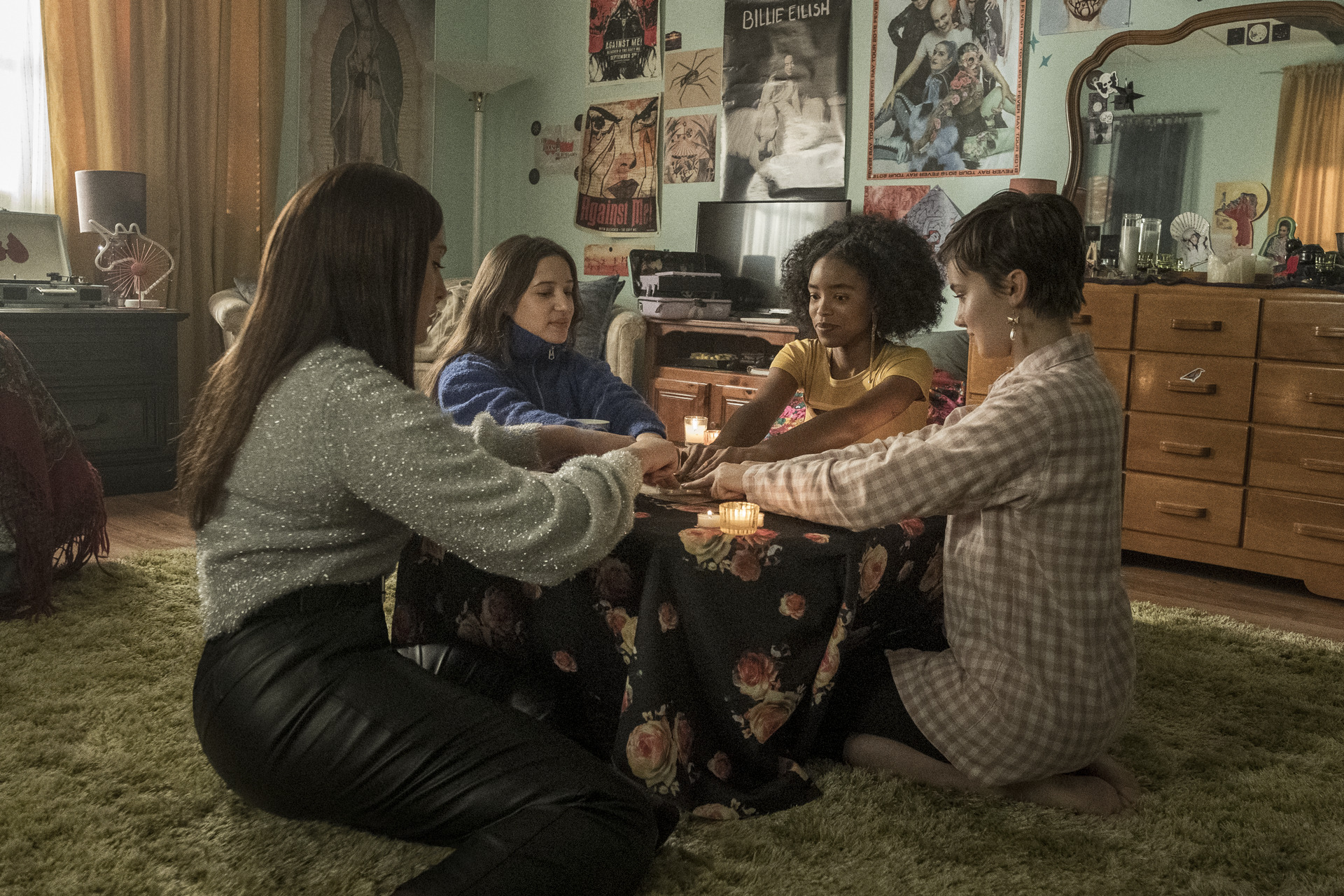
(Left to right) Lourdes (Zoey Luna) Frankie (Gideon Adlon) Tabby (Lovie Simone) and Lily (Cailee Spaeny) perform rituals and talk about being cautious with their gifts in Columbia Pictures’ “The Craft: Legacy.
Kirill: Would you say that the field of cinematography is losing something significant as the medium film is fading away?
Hillary: It’s our challenge and responsibility to bring that to the digital world. At least from my perspective, the challenge is to always make it feel like it has the same weight to it as the films we leaned from, those often shot on film. We work hard to take the digital edge off and make it, at the very least, feel like a hybrid between the two worlds. The tangibility. Often the reference is the look of 35mm, what we did for “The Craft: Legacy”. We wanted to feel like it had the tangibility and texture of being shot on film, to feel that grain, to feel those values.
I don’t know if it’s losing something. I’d like to think that the spirit stays alive in the process and the collective references we all seek and possess. I think it’s our responsibility to continue the traditions. Visual storytelling is visual storytelling, and the medium almost doesn’t matter. It might be shot on iPhone, or on the biggest large format digital sensor, or on 35mm film. Our responsibility as cinematographers is to tell the story through images.
Kirill: How do you talk with people about what you do for a living?
Hillary: I have a lot of people in my life who are do not come from a film background. It’s a good question.
On the base level, cinematographer is involved with everything visual about the project, and that part is one of my favorite things about the craft. The collaboration with directors, production designers, costume designers, gaffers, key grips, camera team, sound effects, visual effects, stunts, etc – that is all involved and part of my responsibility as a cinematographer. Anything that relates to the image.
Getting deeper into it, my responsibility is also to watch, to listen and to interpret vision. That’s the fundamental part. There is this collective vision for the project, and my job is to interpret that and bring that visually to the project. And so much of it is managing, getting everyone on the same page to be working towards the same goal, and that collaboration. It always vacillates between the technical/managerial and the creative.
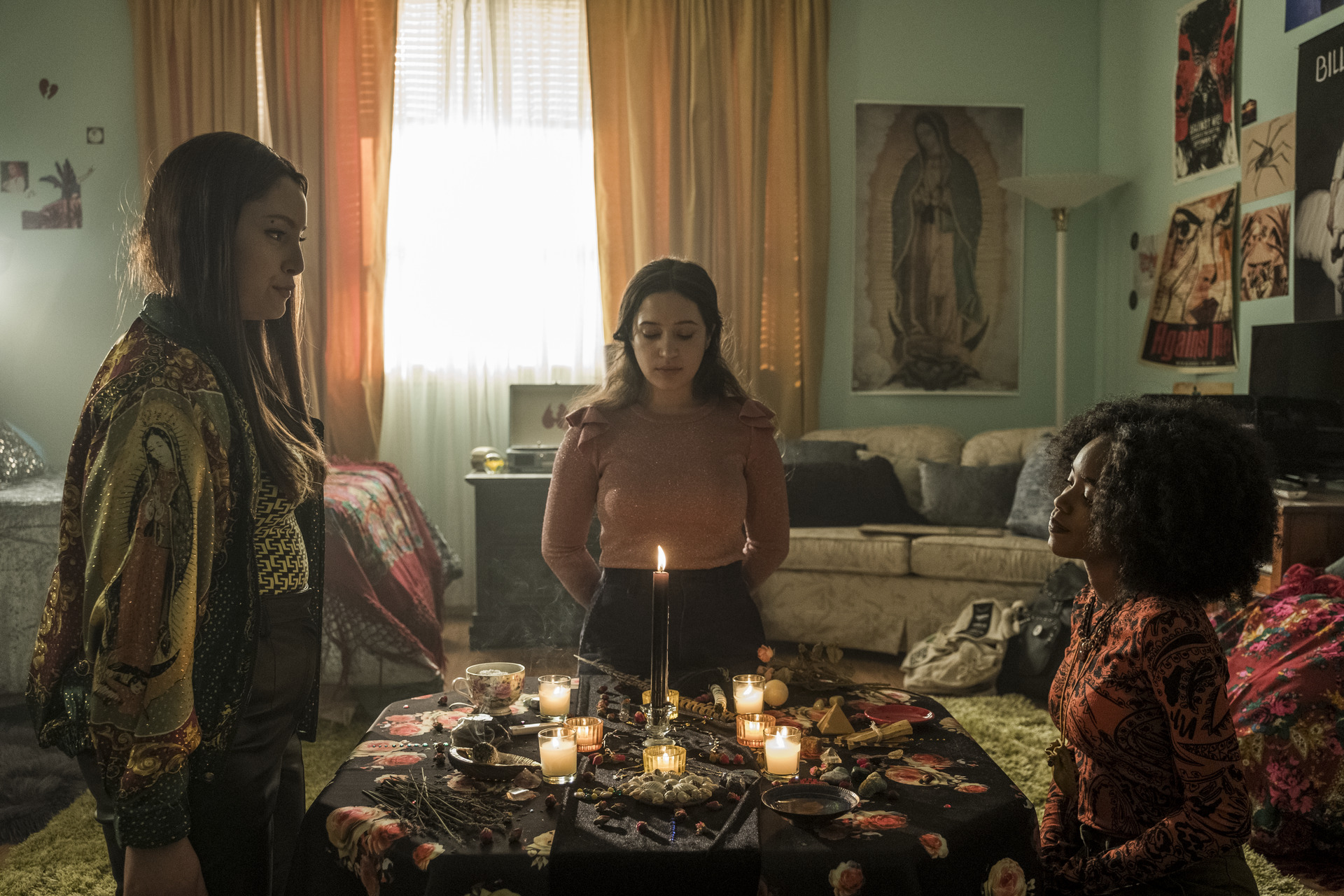
(Left to right) Lourdes (Zoey Luna) Frankie (Gideon Adlon) and Tabby (Lovie Simone) need a fourth to complete their coven in Columbia Pictures’ “The Craft: Legacy”.
Continue reading »
This started happening a few weeks ago. Using Firefox to load Twitter’s webpage would display this text message:
Can’t load twitter : https://twitter.com/ has experienced a network protocol violation that cannot be repaired.
One (rather annoying) way to go around it is to Shift+Reload the page, but you need to do it every single time you load the main stream or just a single tweet. Another, and a more permanent way is to type about:serviceworkers into the address bar, and then search for “twitter” in that page. You should see something like this:

Click the “Unregister” button and you should be good to go.
Substance comes with built-in support for animating state transitions for the core Swing components, as well as for all the Flamingo components.
Let’s take a look at this screenshot from the component states documentation:
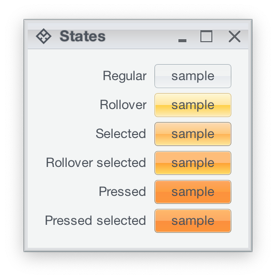
Here we see how one of the Substance skins (Office Silver 2007) provides different visuals for different component states – light yellow for rollover, light orange for selected, deeper orange for pressed, etc. As the component – such as JButton in this case – reacts to the user interaction and changes state, Substance smoothly animates the visuals of that component to reflect the new state. In the case of our JButton, that includes the inner fill, the border and the text.
This comes particularly handy for skins that mix light and dark visuals for different states of the same component. Here is the same UI under the Magellan skin:

Note how the selected button uses light text on dark background, while the rollover selected button uses dark text on light background. If your UI uses the Magellan skin (or any other skin that uses a mix of light and dark color schemes), Substance will do the right thing to animate all relevant parts of your UI as the user interacts with it.
What about the icons?
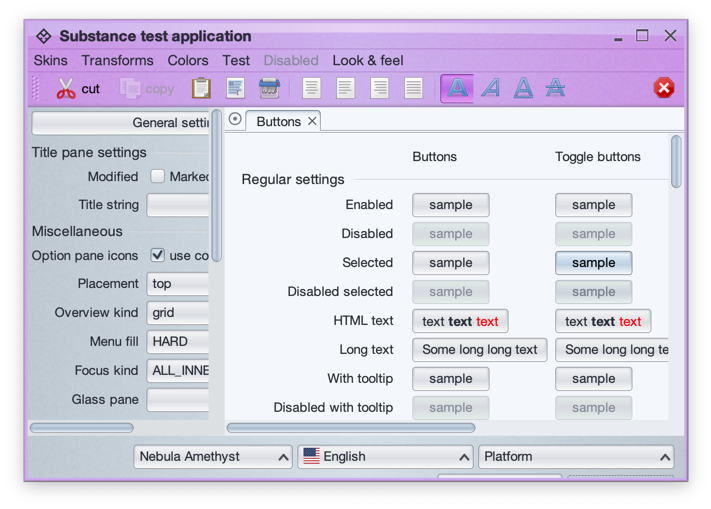
This is a screenshot of the main Substance demo app running under the Nebula Amethyst skin. As UIs with lots of icons can get pretty busy, Substance provides APIs to theme the icons based on the current skin visuals.
The APIs are in the SubstanceCortex class, one in the GlobalScope to apply on all icons in your app, and one in the ComponentScope to configure icon theming for the specific control:
SubstanceCortex.GlobalScope.setIconThemingType for global icon themingSubstanceCortex.ComponentScope.setIconThemingType for per-component icon theming
At the present moment, two icon theming types are supported. The first is SubstanceSlices.IconThemingType.USE_ENABLED_WHEN_INACTIVE which works best for multi-color / multi-tone icons and Substance skins with multi-color color schemes. Here is the same UI with this icon theming type:
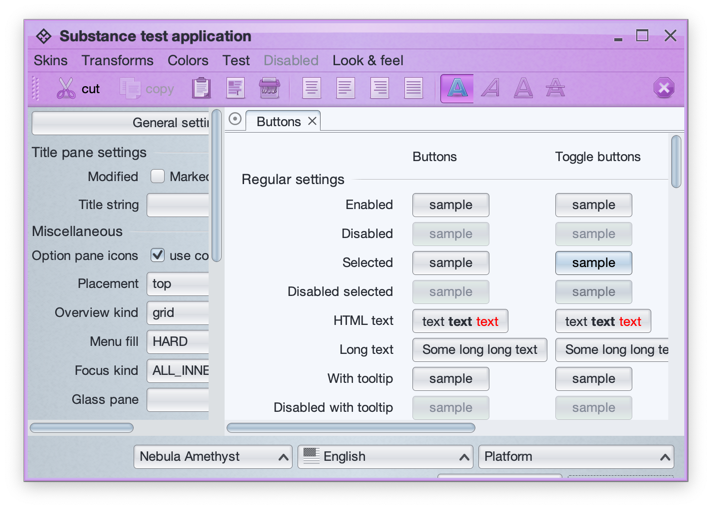
Take a look at the icons in the toolbar. The icon for the active / selected button (bold A) is still in full original color, but the rest of the icons have been themed with the colors of the enabled color scheme configured for the toolbar area of the Nebula Amethyst skin. This work well in this particular case because:
- The original Tango icons have enough contrast to continue being easily recognizable when they are themed in what is essentially a mono-chrome purple color palette
- Nebula Amethyst skin uses color schemes with different background colors for the ultra light to ultra dark range, so that when these colors are used to theme the original icons, the icons remain crisp and legible.
The second option is SubstanceSlices.IconThemingType.FOLLOW_FOREGROUND which works best for single-tone icons found in such popular icon packs as Material, Ionicons, Friconix, Flexicons, Font Awesome and many others:

In this screenshot of the same UI from earlier under the Magellan skin, all the buttons use the same help icon from the Material icon pack converted by Photon. At runtime, Substance themes the icon to follow the foreground / text color of the button for a consistent look across all component states.